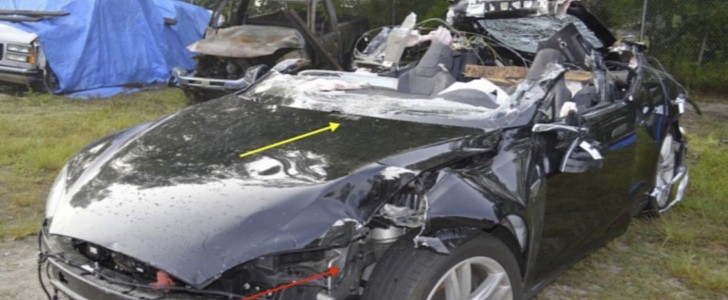The raw numbers revealed on June 15 by the National Highway Traffic Safety Administration (NHTSA) show that most Level 2 advanced driver assistance systems (ADAS) crashes happened with Tesla vehicles: around 70%. At the same time, it is not possible to compare the numbers provided by each automaker because they are not the same and do not follow the same rules. That’s why the National Transportation Safety Board (NTSB) urged NHTSA to standardize this data.
The truth is that NTSB asked for such a standard in 2017 after investigating the first fatal crash involving Tesla Autopilot. On May 7, 2016, Joshua Brown was on his 2015 Tesla Model S 70D traveling eastbound on US-27A west of Williston, Florida. It went underneath a 2014 Freightliner Cascadia with a refrigerated semitrailer. The truck made a left turn from westbound US-27A across the two eastbound travel lanes onto NE 140th Court, a local paved road. Brown was the only occupant of the Tesla, and he died immediately.
Autopilot was active, and its detractors said it should have detected a semitrailer right before it. Tesla investors and advocates blamed the driver because Tesla’s disclaimer says they should always be in control. NTSB concluded that the truck driver failed to yield the right of way to the car, overreliance on Autopilot, and issues with the software’s operational design, which allowed the driver to disengage from the driving task. The phenomenon of believing something is autonomous when it is not was classified as autonowashing by Liza Dixon.
On September 28, 2017, NTSB released the safety recommendation H-17-37 up to H-17-403. This document asked the U.S. Department of Transportation (DOT) to define the data parameters needed to understand ADAS crashes. Among the other recommendations, it also asked NHTSA on H-17-40 to use such parameters to “define a standard format for reporting automated vehicle control systems data, and require manufacturers of vehicles equipped with automated vehicle control systems to report incidents, crashes, and vehicle miles operated with such systems enabled.”
If this recommendation were adopted by 2017 or 2018, NHTSA would have received comparable information from all automakers. As disclosed, Jennifer Homendy classified it as “a good start, but it doesn’t provide an apples-to-apples comparison of advanced vehicle safety.” NTSB’s board chair also said that this “fruit bowl of data” came “with a lot of caveats, making it difficult for the public and experts alike to understand what is being reported.”
An old-time critic of Tesla and the way the company deals with Autopilot and FSD, Homendy went in its defense of the way the data seems to frame the company. She said that "Tesla collects a huge amount of high-quality data, which may mean they’re overrepresented in NHTSA’s release.” Tesla also receives information in real-time, something other carmakers are yet to do.
With that in mind, NTSB’s chair said that “the last thing we want is to penalize manufacturers that collect robust safety data. What we do want is data that tells us what safety improvements need to be made.” For that to happen, there must be a standard for the necessary data and how it is gathered. Curiously, NHTSA’s report ended up being more about the work U.S. authorities have ahead than exactly about ADAS – for now.
Autopilot was active, and its detractors said it should have detected a semitrailer right before it. Tesla investors and advocates blamed the driver because Tesla’s disclaimer says they should always be in control. NTSB concluded that the truck driver failed to yield the right of way to the car, overreliance on Autopilot, and issues with the software’s operational design, which allowed the driver to disengage from the driving task. The phenomenon of believing something is autonomous when it is not was classified as autonowashing by Liza Dixon.
On September 28, 2017, NTSB released the safety recommendation H-17-37 up to H-17-403. This document asked the U.S. Department of Transportation (DOT) to define the data parameters needed to understand ADAS crashes. Among the other recommendations, it also asked NHTSA on H-17-40 to use such parameters to “define a standard format for reporting automated vehicle control systems data, and require manufacturers of vehicles equipped with automated vehicle control systems to report incidents, crashes, and vehicle miles operated with such systems enabled.”
If this recommendation were adopted by 2017 or 2018, NHTSA would have received comparable information from all automakers. As disclosed, Jennifer Homendy classified it as “a good start, but it doesn’t provide an apples-to-apples comparison of advanced vehicle safety.” NTSB’s board chair also said that this “fruit bowl of data” came “with a lot of caveats, making it difficult for the public and experts alike to understand what is being reported.”
An old-time critic of Tesla and the way the company deals with Autopilot and FSD, Homendy went in its defense of the way the data seems to frame the company. She said that "Tesla collects a huge amount of high-quality data, which may mean they’re overrepresented in NHTSA’s release.” Tesla also receives information in real-time, something other carmakers are yet to do.
With that in mind, NTSB’s chair said that “the last thing we want is to penalize manufacturers that collect robust safety data. What we do want is data that tells us what safety improvements need to be made.” For that to happen, there must be a standard for the necessary data and how it is gathered. Curiously, NHTSA’s report ended up being more about the work U.S. authorities have ahead than exactly about ADAS – for now.



















